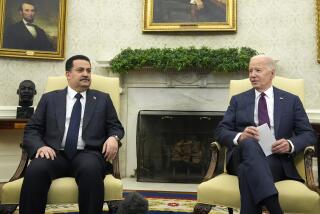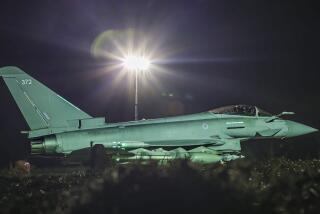U.S. Planes Strike Iraqi Missile Site After Provocation
- Share via
WASHINGTON — U.S. warplanes struck at an Iraqi missile installation Monday after Iraq fired three surface-to-air missiles at American planes on a routine patrol of the “no-fly” zone over Kurdish territory, U.S. officials said. It was the first full military exchange between Iraq and the United States since the end of Operation Desert Fox on Dec. 19.
Iraq’s move appears to mark the beginning of a new phase in its dogged efforts to undermine the U.S. policy of containment. Baghdad’s goal, U.S. officials contend, is to challenge the legitimacy of “no-fly” zones that encompass 60% of Iraqi airspace but are not specifically enshrined in U.N. resolutions.
After the confrontation, Iraq’s U.N. ambassador, Nizar Hamdoun, charged that the zones are illegal because they were not created or approved by the United Nations. Baghdad, therefore, reserves the right to “act in self-defense” when foreign warplanes “intrude” into the skies over Iraq, he said.
In Washington, President Clinton said the aircraft were merely acting in self-defense, and pledged that the U.S. commitment to maintain the zones in northern and southern Iraq will not waver.
“Our pilots have the authority to protect themselves if they are attacked. They took appropriate action today in responding to Iraq’s actions,” Clinton said. “We will continue to enforce the ‘no-fly’ zones.”
Iraq said four Iraqis were killed and seven injured when U.S. warplanes fired HARM missiles, which home in on enemy radar, and precision-guided bombs at an Iraqi antiaircraft installation.
The regime of President Saddam Hussein said American planes initiated the exchange. Iraq returned fire from an SA-3 missile site in self-defense, a military spokesman said.
“The murderers and criminals returned and once again violated our national airspace . . . and fired criminal missiles against one of our sites,” an Iraqi statement said. Iraqi air defense “confronted them with valor and forced them to flee to their bases of evil and aggression in Turkey.”
The Iraqi News Agency quoted a military spokesman as saying Iraq had “almost certainly” shot down one of the U.S. aircraft, but American officials dismissed the claim as groundless.
Both sides agreed that the incident took place near Mosul in northern Kurdistan, which has been patrolled regularly since 1991. The northern zone above the 36th parallel was created by the Bush administration in response to a Kurdish refugee crisis after the Iraqi military moved to quell a Kurdish uprising shortly after the Gulf War.
Monday’s incident was the first exchange of fire in the northern zone since September 1996, according to the Pentagon. All U.S. planes returned safely to Incirlik Air Base in Turkey.
The Clinton administration has been concerned about Iraq’s next moves since Baghdad threatened over the weekend to shoot down coalition aircraft patrolling either “no-fly” zone.
A second zone was imposed below the 32nd parallel in 1992.
The move by the U.S.-led coalition was in response to Iraq’s refusal to allow U.N. weapons inspectors into a government facility and its use of aircraft against its own population in the Shiite-dominated south.
In 1996, the United States extended the southern zone to the 33rd parallel--right up to the gates of Baghdad--in retaliation for Iraq’s deployment of troops in the Kurdish north. Along with economic sanctions, the “no-fly” zones have become critical components of the U.S. strategy to squeeze Hussein’s regime.
“Because we effectively control the skies over much of Iraq, Saddam has been unable to use air power to repress his own people or to lash out again at his neighbors,” Clinton said. “The ‘no-fly’ zones have been, and will remain, an important part of our containment policy.”
In the wake of bombardment by U.S. and British forces in Operation Desert Fox, Iraq appears to be orchestrating a new crisis in an effort to undermine containment and shift attention away from its recent rejection of U.N. efforts to dismantle its capability to manufacture and deploy weapons of mass destruction.
“Iraq can’t sit still. Having decided on a policy of challenges, Saddam has to keep alive the image of Iraq as the victim and the West as perfidious. The ultimate goal is to mobilize Arab and world opinion to say ‘enough is enough’ and to get sanctions off,” said Judith Yaphe, an Iraq specialist at National Defense University in Washington.
“He doesn’t have much left to play with,” Yaphe said. “First it was ‘no’ to the U.N. weapons inspectors. This is the next step. Now it’s ‘no’ to the ‘no-fly’ zones.”
Unlike the disarmament program, which is specifically mandated and administered by the United Nations, the zones have only a vague legal underpinning. U.N. Resolution 688 requires Iraq to cease repression of its people, and other U.N. resolutions prohibit Iraq from aggression against its neighbors. But neither specifies or approves any form of enforcement.
Washington expects Hussein to try to exploit the lack of specific authorization for the zones in an attempt to isolate the United States diplomatically.
“Having failed to break out of sanctions in 1998, he’s going to keep trying in 1999, and he feels the ‘no-fly’ zones are an appropriate target because he’s always rejected them,” said a senior Clinton administration official who requested anonymity.
France, Russia and China have advocated an easing of punitive policies toward Iraq, including sanctions. While the United States appears intent on removing Hussein as a condition to any modifications in existing policy, three of the five U.N. Security Council members are prepared to deal with the current Iraqi leadership. During the past two years, the United Nations has increasingly become an international forum for debating what to do about Iraq.
The United States argues that because the “no-fly” zones are not enshrined in U.N. resolutions, unlike economic sanctions and weapons inspections, they are not subject to debate or discussion in the Security Council.
For the time being, U.S. officials insist that the zones are not threatened.
The two countries that host U.S. and British warplanes used in the patrols are Turkey and Saudi Arabia. Saudi Arabia is one of two countries most vulnerable to Iraqi aggression. And just last week, Turkey’s parliament renewed approval for the use of Turkish bases for flights over the northern zone.
More to Read
Sign up for Essential California
The most important California stories and recommendations in your inbox every morning.
You may occasionally receive promotional content from the Los Angeles Times.













